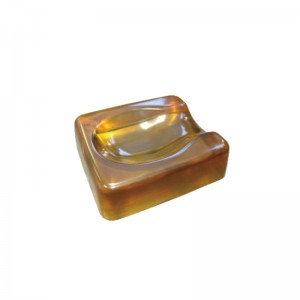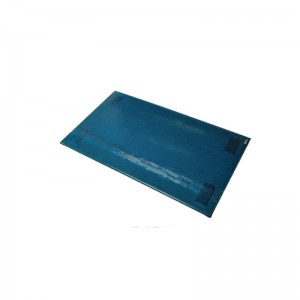
Dome positioner ORP-DP1 (Chest Roll)
Dome Positioner
ORP-DP1
Function
1. Applicable to the prone, supine and lateral position. It can be placed under torso to allow for chest expansion in prone position. It can also be used to support and protect the ankle in prone position and the hip, knee and ankle in supine position.
2. It also can be used in lateral position operation to support and protect armpit.
3. Flat bottom provides stability and keep positioner in place.
| Model | Dimension | Weight |
| ORP-DP1-01 | 32.5 x 11.5 x 10cm | 3.36kg |
| ORP-DP1-02 | 43.5 x 12.5 x 10cm | 4.7kg |
| ORP-DP1-03 | 54.5 x 11.7 x 10cm | 6kg |




Product parameters
Product Name: Positioner
Material: PU Gel
Definition: It is a medical device which is used in an operating room to protect patient from pressure sores during surgery.
Model: Different positioners are used for different surgical positions
Color: Yellow, blue, green. Other colors and sizes can be customized
Product characteristics: Gel is a kind of high molecular material, with good softness, support, shock absorption and compression resistance, good compatibility with human tissues, X-ray transmission, insulation, non-conductive, easy to clean, convenient to disinfect, and does not support bacterial growth.
Function: Avoid pressure ulcer caused by long operation time
Product characteristics
1. The insulation is non-conductive, easy to clean and disinfect. It does not support bacterial growth and has good temperature resistance. The resistance temperature ranges from -10 ℃ to +50 ℃
2. It provides patients with good, comfortable and stable body position fixation. It maximizes the exposure of the surgical field, reduce the operation time, maximize the dispersion of pressure, and reduce the occurrence of pressure ulcer and nerve damage.
Cautions
1. Do not wash the product. If the surface is dirty, wipe the surface with a wet towel. It can also be cleaned with neutral cleaning spray for better effect.
2. After using the product, please clean the surface of the positioners on time to remove dirt, sweat, urine, etc. The fabric can be stored in a dry place after drying in a cool place. After storage, do not put heavy objects on top of the product.
The below information is extracted from AST(Association of Surgical Technologists) Standards of Practice for Surgical Positioning
Standard of Practice III
Based upon the preoperative patient assessment and surgical procedure, the surgical technologist should anticipate the type of OR table and equipment that is needed.
1. The surgical technologist should collaborate with the surgical personnel and healthcare facility purchasing personnel in evaluating and purchasing OR tables and positioning equipment.
A. The surgery and purchasing personnel should analyze the types of surgical procedures performed at the facility, patient population, manufacturers’ recommendations and published research to determine the OR tables and equipment that best meets the needs of the surgery department.
B. The following essential factors should be taken into consideration when purchasing OR tables:
● Stable base
● Easy to maneuver and lock into place
● Easily adjusts into all positions, e.g. height, Trendelenburg, reverse Trendelenburg, lateral tilt, central break
● Easy-to-add positioning equipment and adjust, e.g. armboards, stirrups, kidney rests, move head section to foot of OR table
● Radiolucent to allow taking X-rays or using fluoroscope
● Able to safely support patients. Based on analysis of types of surgical procedures performed and patient population, the surgery and purchasing personnel should request the manufacturer to provide information concerning the maximum patient weight the OR table can safely support. It may be necessary to purchase heavy-duty OR tables that can support up to 1,000 pounds.
● Easy to clean
C. One of the most important safety factors that should be taken into consideration when purchasing OR tables is the mattresses and ability to evenly distribute the body pressure to prevent circulatory disturbances and pressure ulcers at the bony prominences.
(1) The routine mattress is foam covered with nylon or vinyl. An alternative is the gel mattress. Research results have not provided a definitive answer regarding which type is best for preventing intraoperative skin injuries and pressure ulcers. The surgery and purchasing personnel should request the manufacturer to provide information including research that has been performed on the mattresses being considered for purchase. Additionally, the personnel should be allowed by the manufacturer to use the mattresses on a test basis to determine which performs the best and meets the needs of the facility and patients.
However, the surgery and purchasing personnel should base their decisions on the following factors:
● Based upon analysis of surgical procedures performed, mattresses are appropriate for the requirements of the various surgical positions, including availability of different sizes and foam thickness;
● Made of resilient, long-lasting material, including no breakdown when cleaned with disinfectant agents;
● Radiolucent (if surgery department performs procedures that require intraoperative imaging studies);
● Moisture resistant;
● Fire retardant;
● Nonallergenic, in particular, no presence of latex in material;
D. Even if the surgery department does not perform bariatric surgical procedures, it is still required that the department be prepared for performing other types of surgical procedures on obese patients.
(1) The surgery and purchasing personnel should analyze the needs of the surgery department and purchase positioning equipment that safely meets the needs for positioning the patient, including patient transfer lifts to move the obese patient from the stretcher to the OR table and heavy-duty OR table that safely supports the patient, but allows articulation to place the patient in the surgical position.








